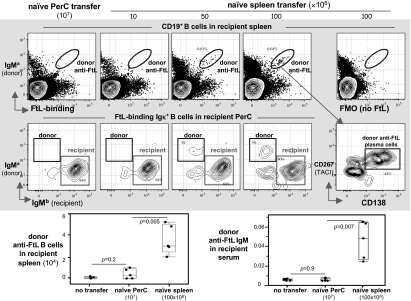Fig. 4.
Naïve spleen, but not naïve PerC, produce anti-FtL primary responses to FtL challenge when transferred intravenously to naïve recipients. (Top) 107 PerC (from one to two naïve mice) or indicated number of spleen cells from naïve Igha mice were transferred intravenously to naïve congenic Ighb recipients immunized with FtL the next day. Donor and recipient anti-FtL responses were measured 5 d later. (Middle) Live B cells from indicated recipient spleen were gated to identify donor anti-FtL B-1a (IgMa+) (circled population, Top), which are then further gated to show donor anti-FtL plasma cells (CD267hiCD138+, boxed population, Rightmost Middle). CD267, transmembrane activator, and calcium signal-modulating cyclophilin ligand interactor (TACI) is a marker induced during plasma cell differentiation. The boundary for FtL binding is determined from the fluorescence-minus-one (FMO) (40) staining control in which fluorochrome-labeled FtL was omitted from the stain-set (Rightmost Top). Live PerC anti-FtL B-1a were gated to distinguish donor or recipient-derived cells (boxed populations, Middle). (Bottom) Numbers of donor (IgMa) anti-FtL B-1a in recipient spleen (Left); donor-derived (IgMa) anti-FtL in sera of recipients (Right). Each point represents data from an individual mouse (n = 5, per group). Values are expressed as microliter equivalents of a standard serum pool from 5-d FtL-primed Igha mice.

